Is Workplace Bullying Serious Enough to Warrant Legal Actions? SBM3204
VerifiedAdded on 2022/09/26
|10
|2225
|22
Report
AI Summary
This report examines the critical question of whether workplace bullying is serious enough to warrant legal action. It delves into the definition and prevalence of bullying, highlighting both person-related and work-related forms. The report presents arguments supporting legal action, emphasizing the detrimental impacts on employees' mental and physical health, as well as the legal recourse available, such as the Fair Work Amendment Act 2013 in Australia. Conversely, it explores the opposing viewpoint, considering the adverse effects of legal intervention on managerial capabilities and the potential for internal solutions. The report discusses the implications for both managers and employees, including the role of emotional intelligence and self-management techniques in mitigating bullying. The conclusion advocates for legal action while suggesting a detailed case analysis before legal proceedings. It emphasizes the importance of a fair workplace environment and the need for strategic management approaches.

Student Name
INSTITUTIONAL AFFILIATION(S)
SBM3204
INSTITUTIONAL AFFILIATION(S)
SBM3204
Paraphrase This Document
Need a fresh take? Get an instant paraphrase of this document with our AI Paraphraser
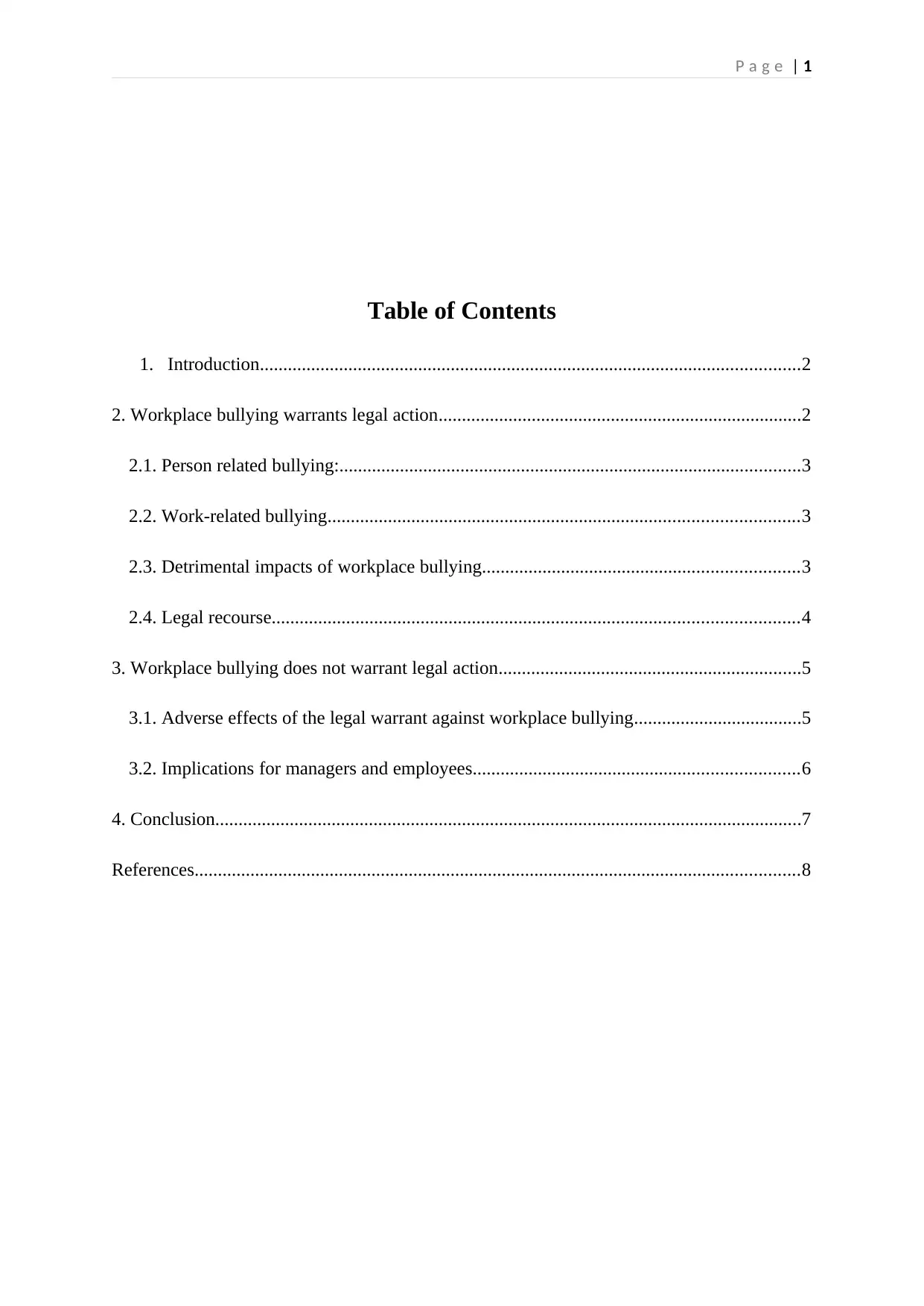
P a g e | 1
Table of Contents
1. Introduction....................................................................................................................2
2. Workplace bullying warrants legal action..............................................................................2
2.1. Person related bullying:...................................................................................................3
2.2. Work-related bullying.....................................................................................................3
2.3. Detrimental impacts of workplace bullying....................................................................3
2.4. Legal recourse.................................................................................................................4
3. Workplace bullying does not warrant legal action.................................................................5
3.1. Adverse effects of the legal warrant against workplace bullying....................................5
3.2. Implications for managers and employees......................................................................6
4. Conclusion..............................................................................................................................7
References..................................................................................................................................8
Table of Contents
1. Introduction....................................................................................................................2
2. Workplace bullying warrants legal action..............................................................................2
2.1. Person related bullying:...................................................................................................3
2.2. Work-related bullying.....................................................................................................3
2.3. Detrimental impacts of workplace bullying....................................................................3
2.4. Legal recourse.................................................................................................................4
3. Workplace bullying does not warrant legal action.................................................................5
3.1. Adverse effects of the legal warrant against workplace bullying....................................5
3.2. Implications for managers and employees......................................................................6
4. Conclusion..............................................................................................................................7
References..................................................................................................................................8
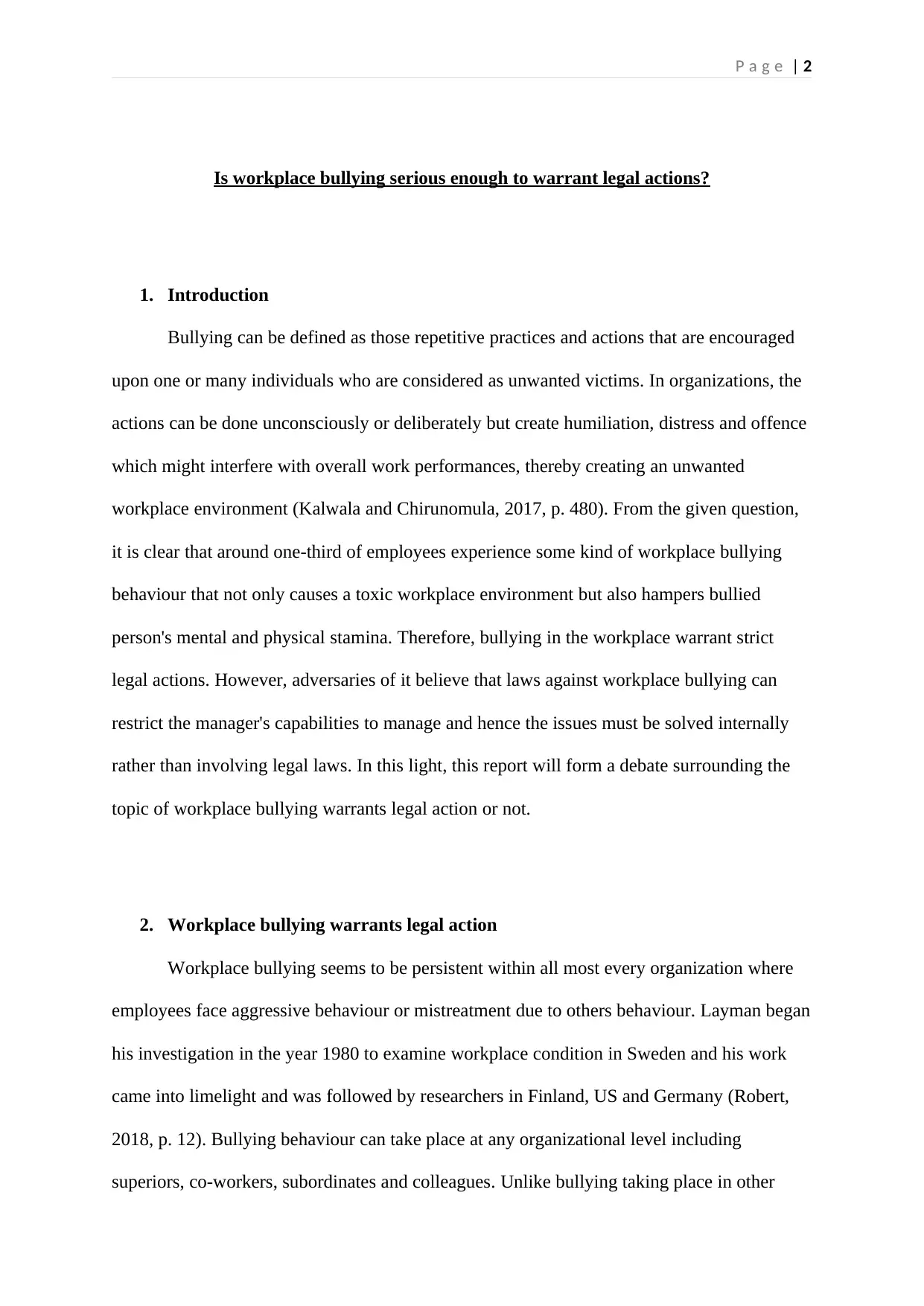
P a g e | 2
Is workplace bullying serious enough to warrant legal actions?
1. Introduction
Bullying can be defined as those repetitive practices and actions that are encouraged
upon one or many individuals who are considered as unwanted victims. In organizations, the
actions can be done unconsciously or deliberately but create humiliation, distress and offence
which might interfere with overall work performances, thereby creating an unwanted
workplace environment (Kalwala and Chirunomula, 2017, p. 480). From the given question,
it is clear that around one-third of employees experience some kind of workplace bullying
behaviour that not only causes a toxic workplace environment but also hampers bullied
person's mental and physical stamina. Therefore, bullying in the workplace warrant strict
legal actions. However, adversaries of it believe that laws against workplace bullying can
restrict the manager's capabilities to manage and hence the issues must be solved internally
rather than involving legal laws. In this light, this report will form a debate surrounding the
topic of workplace bullying warrants legal action or not.
2. Workplace bullying warrants legal action
Workplace bullying seems to be persistent within all most every organization where
employees face aggressive behaviour or mistreatment due to others behaviour. Layman began
his investigation in the year 1980 to examine workplace condition in Sweden and his work
came into limelight and was followed by researchers in Finland, US and Germany (Robert,
2018, p. 12). Bullying behaviour can take place at any organizational level including
superiors, co-workers, subordinates and colleagues. Unlike bullying taking place in other
Is workplace bullying serious enough to warrant legal actions?
1. Introduction
Bullying can be defined as those repetitive practices and actions that are encouraged
upon one or many individuals who are considered as unwanted victims. In organizations, the
actions can be done unconsciously or deliberately but create humiliation, distress and offence
which might interfere with overall work performances, thereby creating an unwanted
workplace environment (Kalwala and Chirunomula, 2017, p. 480). From the given question,
it is clear that around one-third of employees experience some kind of workplace bullying
behaviour that not only causes a toxic workplace environment but also hampers bullied
person's mental and physical stamina. Therefore, bullying in the workplace warrant strict
legal actions. However, adversaries of it believe that laws against workplace bullying can
restrict the manager's capabilities to manage and hence the issues must be solved internally
rather than involving legal laws. In this light, this report will form a debate surrounding the
topic of workplace bullying warrants legal action or not.
2. Workplace bullying warrants legal action
Workplace bullying seems to be persistent within all most every organization where
employees face aggressive behaviour or mistreatment due to others behaviour. Layman began
his investigation in the year 1980 to examine workplace condition in Sweden and his work
came into limelight and was followed by researchers in Finland, US and Germany (Robert,
2018, p. 12). Bullying behaviour can take place at any organizational level including
superiors, co-workers, subordinates and colleagues. Unlike bullying taking place in other
⊘ This is a preview!⊘
Do you want full access?
Subscribe today to unlock all pages.

Trusted by 1+ million students worldwide
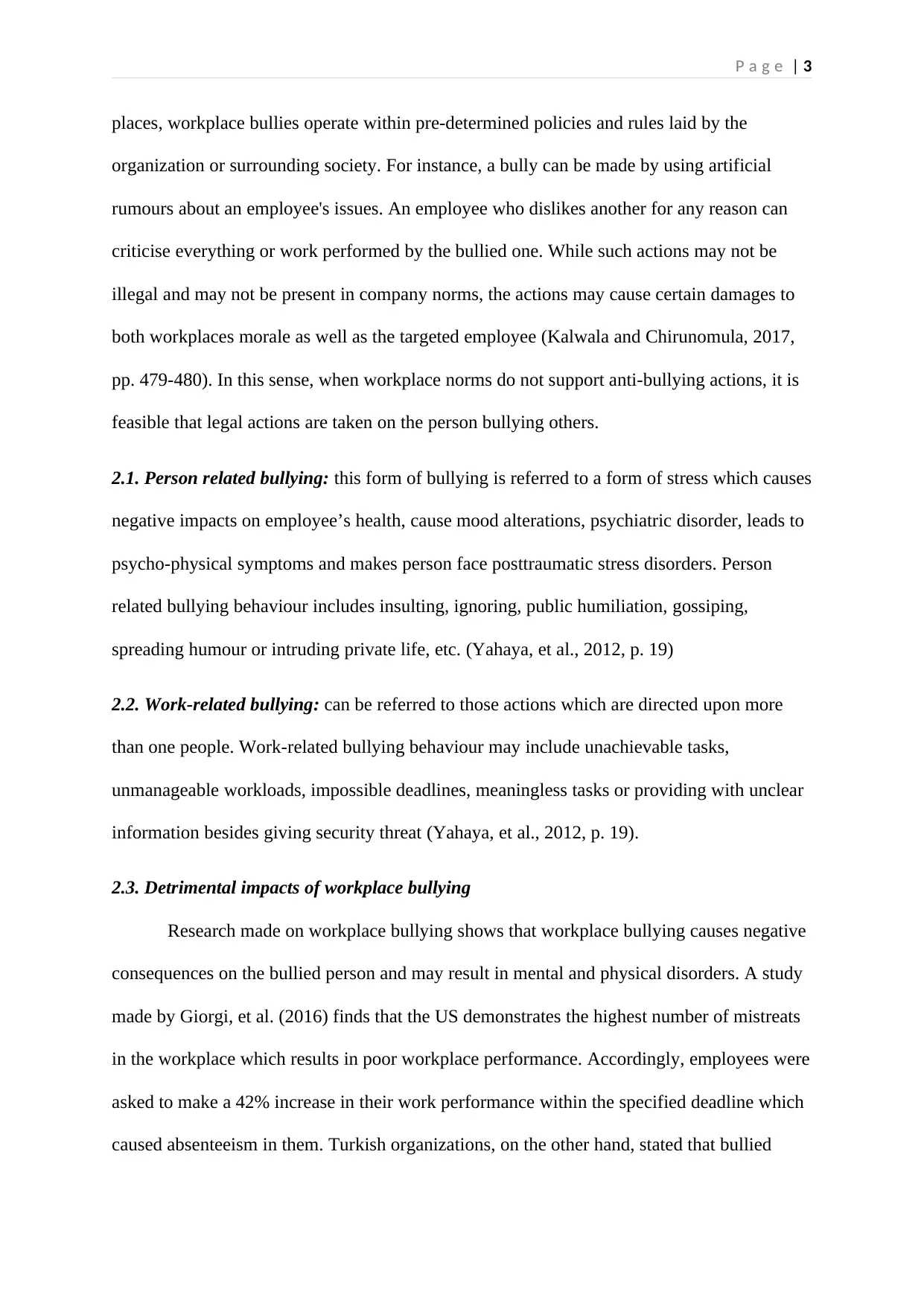
P a g e | 3
places, workplace bullies operate within pre-determined policies and rules laid by the
organization or surrounding society. For instance, a bully can be made by using artificial
rumours about an employee's issues. An employee who dislikes another for any reason can
criticise everything or work performed by the bullied one. While such actions may not be
illegal and may not be present in company norms, the actions may cause certain damages to
both workplaces morale as well as the targeted employee (Kalwala and Chirunomula, 2017,
pp. 479-480). In this sense, when workplace norms do not support anti-bullying actions, it is
feasible that legal actions are taken on the person bullying others.
2.1. Person related bullying: this form of bullying is referred to a form of stress which causes
negative impacts on employee’s health, cause mood alterations, psychiatric disorder, leads to
psycho-physical symptoms and makes person face posttraumatic stress disorders. Person
related bullying behaviour includes insulting, ignoring, public humiliation, gossiping,
spreading humour or intruding private life, etc. (Yahaya, et al., 2012, p. 19)
2.2. Work-related bullying: can be referred to those actions which are directed upon more
than one people. Work-related bullying behaviour may include unachievable tasks,
unmanageable workloads, impossible deadlines, meaningless tasks or providing with unclear
information besides giving security threat (Yahaya, et al., 2012, p. 19).
2.3. Detrimental impacts of workplace bullying
Research made on workplace bullying shows that workplace bullying causes negative
consequences on the bullied person and may result in mental and physical disorders. A study
made by Giorgi, et al. (2016) finds that the US demonstrates the highest number of mistreats
in the workplace which results in poor workplace performance. Accordingly, employees were
asked to make a 42% increase in their work performance within the specified deadline which
caused absenteeism in them. Turkish organizations, on the other hand, stated that bullied
places, workplace bullies operate within pre-determined policies and rules laid by the
organization or surrounding society. For instance, a bully can be made by using artificial
rumours about an employee's issues. An employee who dislikes another for any reason can
criticise everything or work performed by the bullied one. While such actions may not be
illegal and may not be present in company norms, the actions may cause certain damages to
both workplaces morale as well as the targeted employee (Kalwala and Chirunomula, 2017,
pp. 479-480). In this sense, when workplace norms do not support anti-bullying actions, it is
feasible that legal actions are taken on the person bullying others.
2.1. Person related bullying: this form of bullying is referred to a form of stress which causes
negative impacts on employee’s health, cause mood alterations, psychiatric disorder, leads to
psycho-physical symptoms and makes person face posttraumatic stress disorders. Person
related bullying behaviour includes insulting, ignoring, public humiliation, gossiping,
spreading humour or intruding private life, etc. (Yahaya, et al., 2012, p. 19)
2.2. Work-related bullying: can be referred to those actions which are directed upon more
than one people. Work-related bullying behaviour may include unachievable tasks,
unmanageable workloads, impossible deadlines, meaningless tasks or providing with unclear
information besides giving security threat (Yahaya, et al., 2012, p. 19).
2.3. Detrimental impacts of workplace bullying
Research made on workplace bullying shows that workplace bullying causes negative
consequences on the bullied person and may result in mental and physical disorders. A study
made by Giorgi, et al. (2016) finds that the US demonstrates the highest number of mistreats
in the workplace which results in poor workplace performance. Accordingly, employees were
asked to make a 42% increase in their work performance within the specified deadline which
caused absenteeism in them. Turkish organizations, on the other hand, stated that bullied
Paraphrase This Document
Need a fresh take? Get an instant paraphrase of this document with our AI Paraphraser
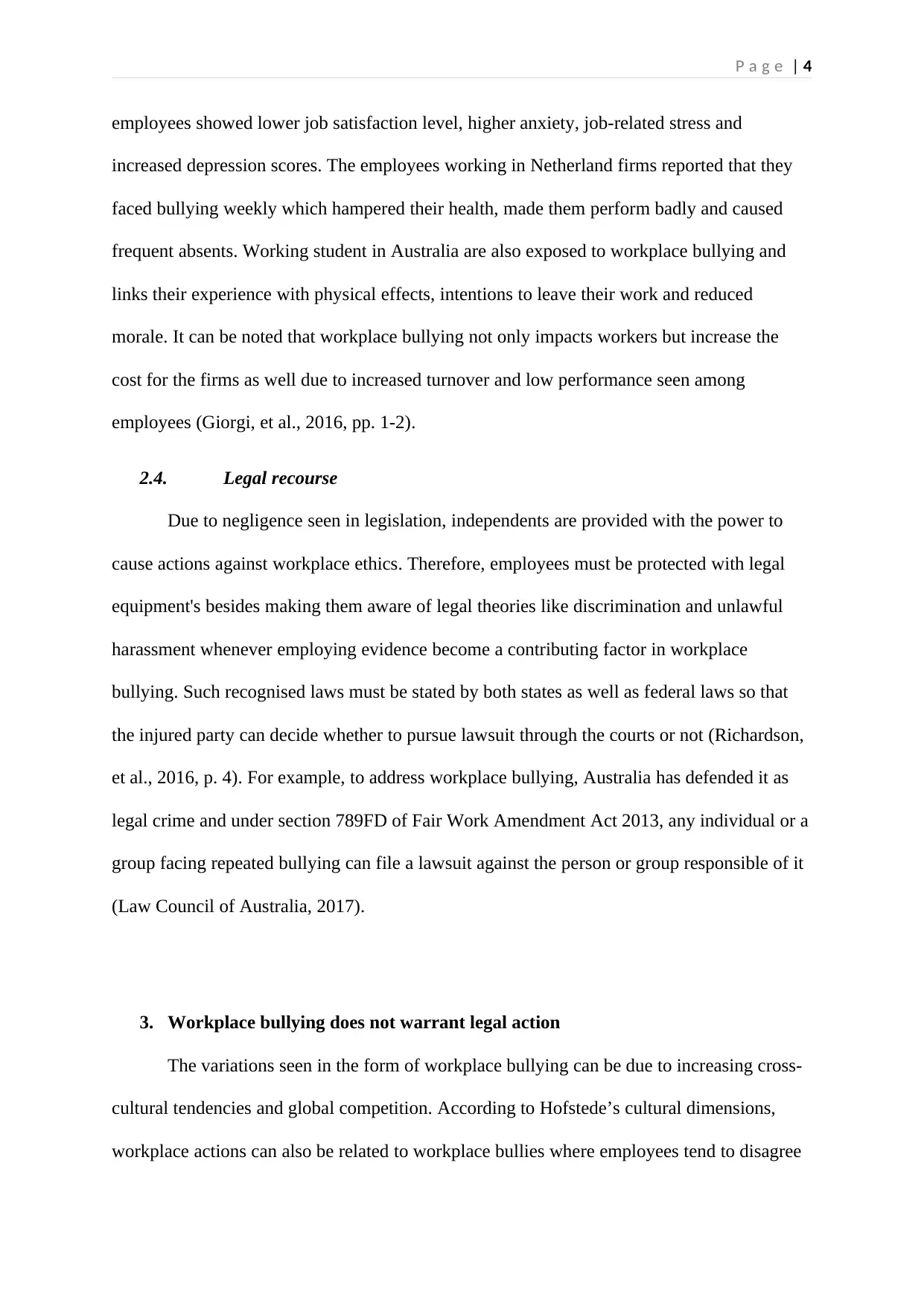
P a g e | 4
employees showed lower job satisfaction level, higher anxiety, job-related stress and
increased depression scores. The employees working in Netherland firms reported that they
faced bullying weekly which hampered their health, made them perform badly and caused
frequent absents. Working student in Australia are also exposed to workplace bullying and
links their experience with physical effects, intentions to leave their work and reduced
morale. It can be noted that workplace bullying not only impacts workers but increase the
cost for the firms as well due to increased turnover and low performance seen among
employees (Giorgi, et al., 2016, pp. 1-2).
2.4. Legal recourse
Due to negligence seen in legislation, independents are provided with the power to
cause actions against workplace ethics. Therefore, employees must be protected with legal
equipment's besides making them aware of legal theories like discrimination and unlawful
harassment whenever employing evidence become a contributing factor in workplace
bullying. Such recognised laws must be stated by both states as well as federal laws so that
the injured party can decide whether to pursue lawsuit through the courts or not (Richardson,
et al., 2016, p. 4). For example, to address workplace bullying, Australia has defended it as
legal crime and under section 789FD of Fair Work Amendment Act 2013, any individual or a
group facing repeated bullying can file a lawsuit against the person or group responsible of it
(Law Council of Australia, 2017).
3. Workplace bullying does not warrant legal action
The variations seen in the form of workplace bullying can be due to increasing cross-
cultural tendencies and global competition. According to Hofstede’s cultural dimensions,
workplace actions can also be related to workplace bullies where employees tend to disagree
employees showed lower job satisfaction level, higher anxiety, job-related stress and
increased depression scores. The employees working in Netherland firms reported that they
faced bullying weekly which hampered their health, made them perform badly and caused
frequent absents. Working student in Australia are also exposed to workplace bullying and
links their experience with physical effects, intentions to leave their work and reduced
morale. It can be noted that workplace bullying not only impacts workers but increase the
cost for the firms as well due to increased turnover and low performance seen among
employees (Giorgi, et al., 2016, pp. 1-2).
2.4. Legal recourse
Due to negligence seen in legislation, independents are provided with the power to
cause actions against workplace ethics. Therefore, employees must be protected with legal
equipment's besides making them aware of legal theories like discrimination and unlawful
harassment whenever employing evidence become a contributing factor in workplace
bullying. Such recognised laws must be stated by both states as well as federal laws so that
the injured party can decide whether to pursue lawsuit through the courts or not (Richardson,
et al., 2016, p. 4). For example, to address workplace bullying, Australia has defended it as
legal crime and under section 789FD of Fair Work Amendment Act 2013, any individual or a
group facing repeated bullying can file a lawsuit against the person or group responsible of it
(Law Council of Australia, 2017).
3. Workplace bullying does not warrant legal action
The variations seen in the form of workplace bullying can be due to increasing cross-
cultural tendencies and global competition. According to Hofstede’s cultural dimensions,
workplace actions can also be related to workplace bullies where employees tend to disagree
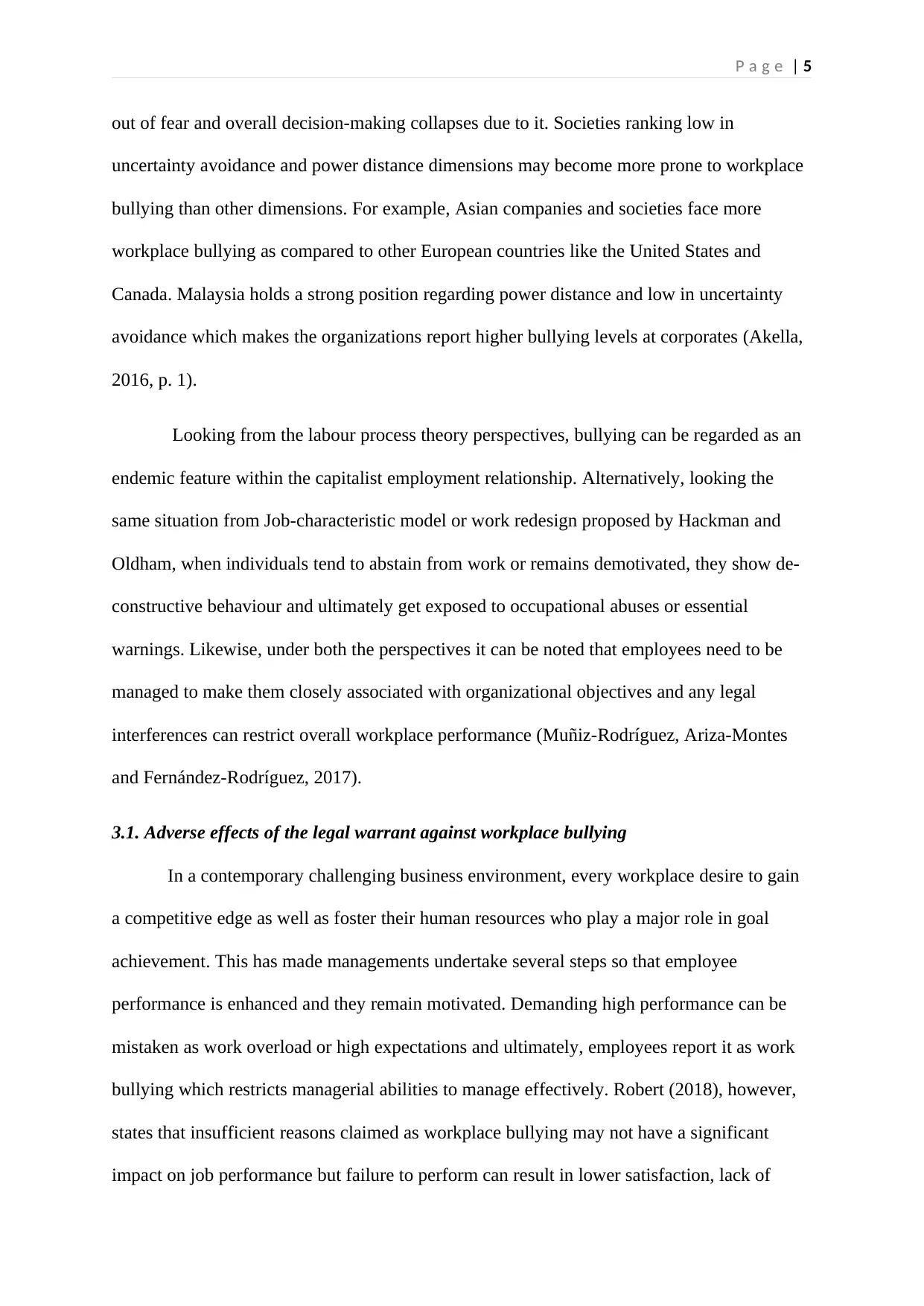
P a g e | 5
out of fear and overall decision-making collapses due to it. Societies ranking low in
uncertainty avoidance and power distance dimensions may become more prone to workplace
bullying than other dimensions. For example, Asian companies and societies face more
workplace bullying as compared to other European countries like the United States and
Canada. Malaysia holds a strong position regarding power distance and low in uncertainty
avoidance which makes the organizations report higher bullying levels at corporates (Akella,
2016, p. 1).
Looking from the labour process theory perspectives, bullying can be regarded as an
endemic feature within the capitalist employment relationship. Alternatively, looking the
same situation from Job-characteristic model or work redesign proposed by Hackman and
Oldham, when individuals tend to abstain from work or remains demotivated, they show de-
constructive behaviour and ultimately get exposed to occupational abuses or essential
warnings. Likewise, under both the perspectives it can be noted that employees need to be
managed to make them closely associated with organizational objectives and any legal
interferences can restrict overall workplace performance (Muñiz-Rodríguez, Ariza-Montes
and Fernández-Rodríguez, 2017).
3.1. Adverse effects of the legal warrant against workplace bullying
In a contemporary challenging business environment, every workplace desire to gain
a competitive edge as well as foster their human resources who play a major role in goal
achievement. This has made managements undertake several steps so that employee
performance is enhanced and they remain motivated. Demanding high performance can be
mistaken as work overload or high expectations and ultimately, employees report it as work
bullying which restricts managerial abilities to manage effectively. Robert (2018), however,
states that insufficient reasons claimed as workplace bullying may not have a significant
impact on job performance but failure to perform can result in lower satisfaction, lack of
out of fear and overall decision-making collapses due to it. Societies ranking low in
uncertainty avoidance and power distance dimensions may become more prone to workplace
bullying than other dimensions. For example, Asian companies and societies face more
workplace bullying as compared to other European countries like the United States and
Canada. Malaysia holds a strong position regarding power distance and low in uncertainty
avoidance which makes the organizations report higher bullying levels at corporates (Akella,
2016, p. 1).
Looking from the labour process theory perspectives, bullying can be regarded as an
endemic feature within the capitalist employment relationship. Alternatively, looking the
same situation from Job-characteristic model or work redesign proposed by Hackman and
Oldham, when individuals tend to abstain from work or remains demotivated, they show de-
constructive behaviour and ultimately get exposed to occupational abuses or essential
warnings. Likewise, under both the perspectives it can be noted that employees need to be
managed to make them closely associated with organizational objectives and any legal
interferences can restrict overall workplace performance (Muñiz-Rodríguez, Ariza-Montes
and Fernández-Rodríguez, 2017).
3.1. Adverse effects of the legal warrant against workplace bullying
In a contemporary challenging business environment, every workplace desire to gain
a competitive edge as well as foster their human resources who play a major role in goal
achievement. This has made managements undertake several steps so that employee
performance is enhanced and they remain motivated. Demanding high performance can be
mistaken as work overload or high expectations and ultimately, employees report it as work
bullying which restricts managerial abilities to manage effectively. Robert (2018), however,
states that insufficient reasons claimed as workplace bullying may not have a significant
impact on job performance but failure to perform can result in lower satisfaction, lack of
⊘ This is a preview!⊘
Do you want full access?
Subscribe today to unlock all pages.

Trusted by 1+ million students worldwide
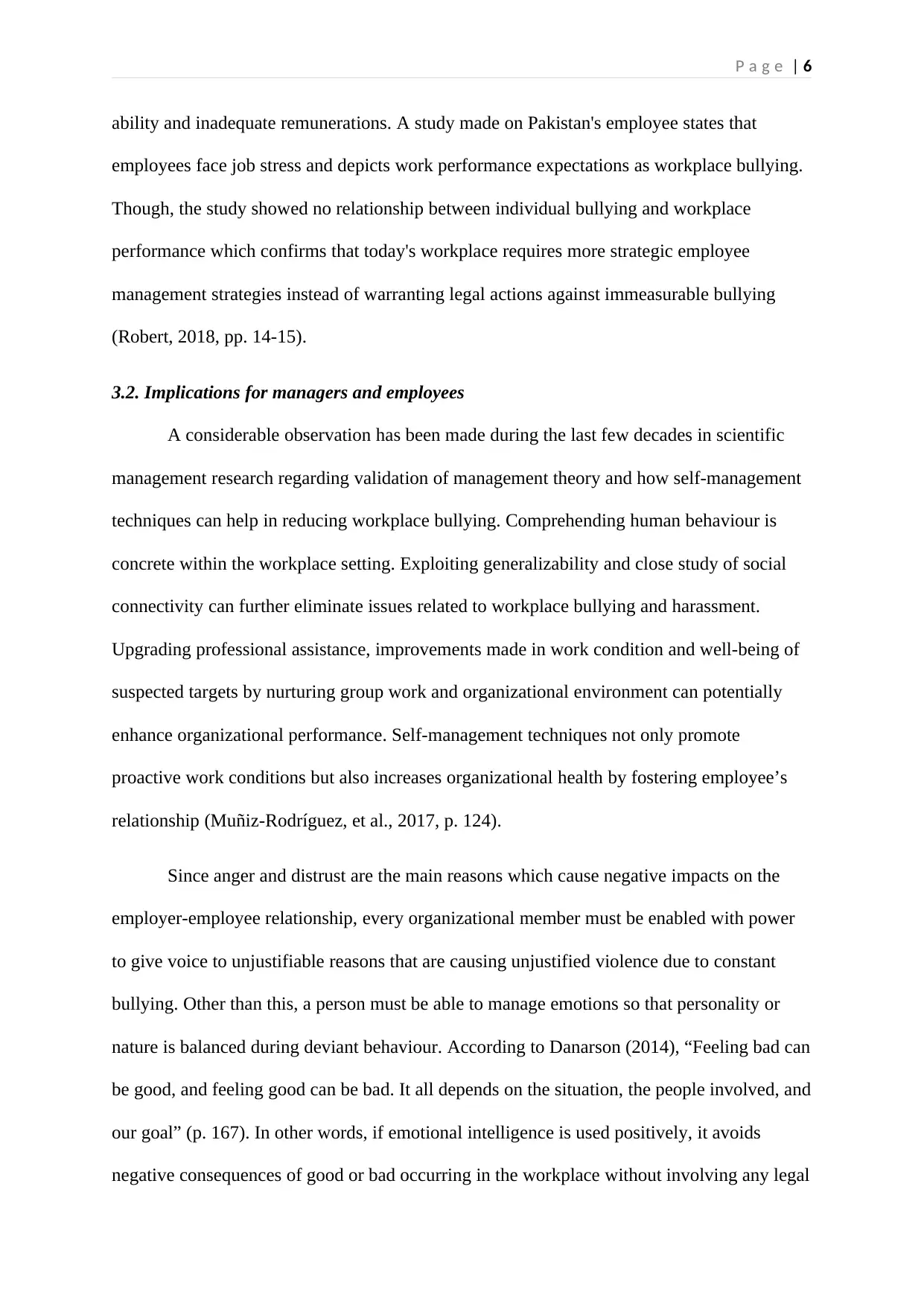
P a g e | 6
ability and inadequate remunerations. A study made on Pakistan's employee states that
employees face job stress and depicts work performance expectations as workplace bullying.
Though, the study showed no relationship between individual bullying and workplace
performance which confirms that today's workplace requires more strategic employee
management strategies instead of warranting legal actions against immeasurable bullying
(Robert, 2018, pp. 14-15).
3.2. Implications for managers and employees
A considerable observation has been made during the last few decades in scientific
management research regarding validation of management theory and how self-management
techniques can help in reducing workplace bullying. Comprehending human behaviour is
concrete within the workplace setting. Exploiting generalizability and close study of social
connectivity can further eliminate issues related to workplace bullying and harassment.
Upgrading professional assistance, improvements made in work condition and well-being of
suspected targets by nurturing group work and organizational environment can potentially
enhance organizational performance. Self-management techniques not only promote
proactive work conditions but also increases organizational health by fostering employee’s
relationship (Muñiz-Rodríguez, et al., 2017, p. 124).
Since anger and distrust are the main reasons which cause negative impacts on the
employer-employee relationship, every organizational member must be enabled with power
to give voice to unjustifiable reasons that are causing unjustified violence due to constant
bullying. Other than this, a person must be able to manage emotions so that personality or
nature is balanced during deviant behaviour. According to Danarson (2014), “Feeling bad can
be good, and feeling good can be bad. It all depends on the situation, the people involved, and
our goal” (p. 167). In other words, if emotional intelligence is used positively, it avoids
negative consequences of good or bad occurring in the workplace without involving any legal
ability and inadequate remunerations. A study made on Pakistan's employee states that
employees face job stress and depicts work performance expectations as workplace bullying.
Though, the study showed no relationship between individual bullying and workplace
performance which confirms that today's workplace requires more strategic employee
management strategies instead of warranting legal actions against immeasurable bullying
(Robert, 2018, pp. 14-15).
3.2. Implications for managers and employees
A considerable observation has been made during the last few decades in scientific
management research regarding validation of management theory and how self-management
techniques can help in reducing workplace bullying. Comprehending human behaviour is
concrete within the workplace setting. Exploiting generalizability and close study of social
connectivity can further eliminate issues related to workplace bullying and harassment.
Upgrading professional assistance, improvements made in work condition and well-being of
suspected targets by nurturing group work and organizational environment can potentially
enhance organizational performance. Self-management techniques not only promote
proactive work conditions but also increases organizational health by fostering employee’s
relationship (Muñiz-Rodríguez, et al., 2017, p. 124).
Since anger and distrust are the main reasons which cause negative impacts on the
employer-employee relationship, every organizational member must be enabled with power
to give voice to unjustifiable reasons that are causing unjustified violence due to constant
bullying. Other than this, a person must be able to manage emotions so that personality or
nature is balanced during deviant behaviour. According to Danarson (2014), “Feeling bad can
be good, and feeling good can be bad. It all depends on the situation, the people involved, and
our goal” (p. 167). In other words, if emotional intelligence is used positively, it avoids
negative consequences of good or bad occurring in the workplace without involving any legal
Paraphrase This Document
Need a fresh take? Get an instant paraphrase of this document with our AI Paraphraser
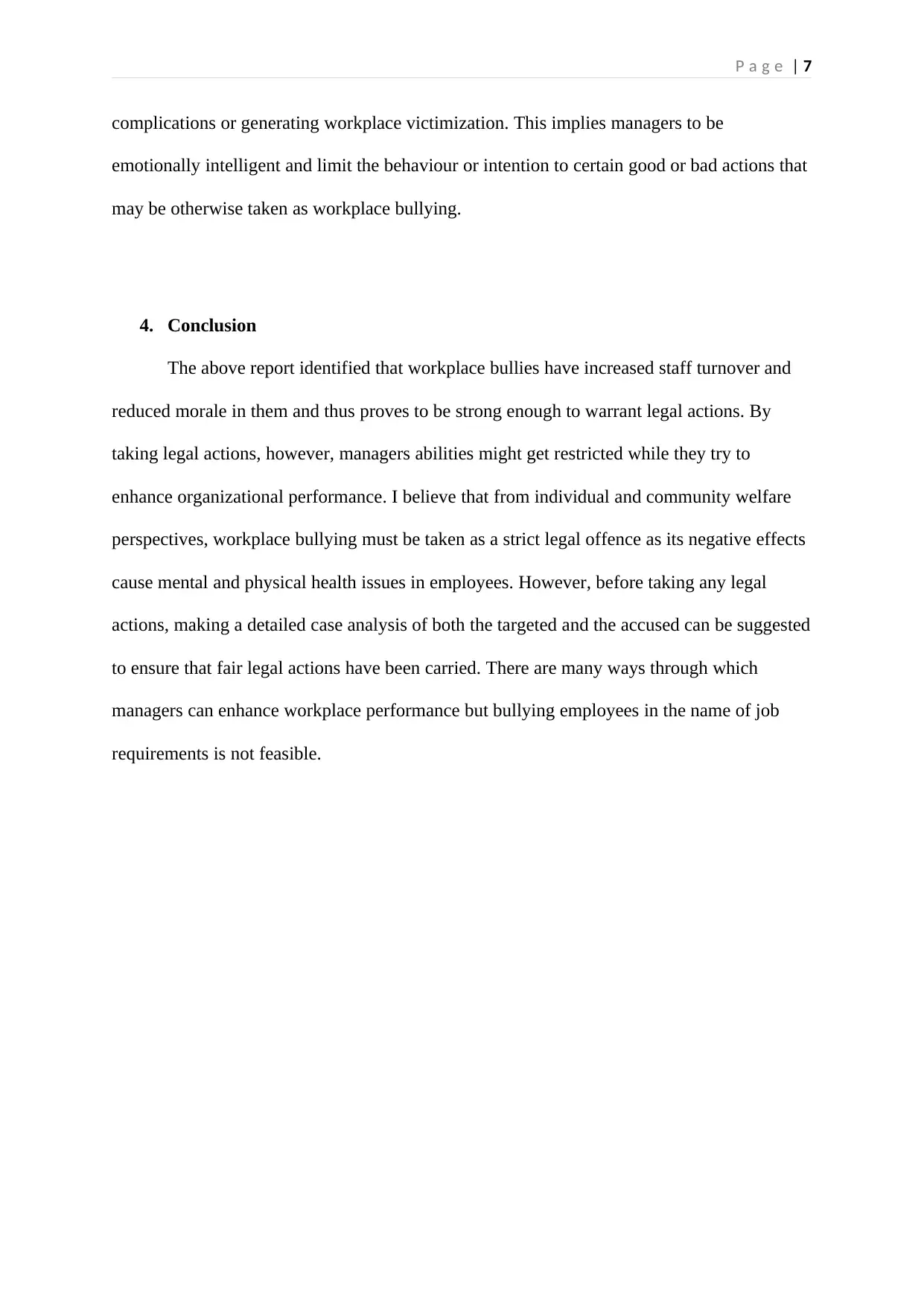
P a g e | 7
complications or generating workplace victimization. This implies managers to be
emotionally intelligent and limit the behaviour or intention to certain good or bad actions that
may be otherwise taken as workplace bullying.
4. Conclusion
The above report identified that workplace bullies have increased staff turnover and
reduced morale in them and thus proves to be strong enough to warrant legal actions. By
taking legal actions, however, managers abilities might get restricted while they try to
enhance organizational performance. I believe that from individual and community welfare
perspectives, workplace bullying must be taken as a strict legal offence as its negative effects
cause mental and physical health issues in employees. However, before taking any legal
actions, making a detailed case analysis of both the targeted and the accused can be suggested
to ensure that fair legal actions have been carried. There are many ways through which
managers can enhance workplace performance but bullying employees in the name of job
requirements is not feasible.
complications or generating workplace victimization. This implies managers to be
emotionally intelligent and limit the behaviour or intention to certain good or bad actions that
may be otherwise taken as workplace bullying.
4. Conclusion
The above report identified that workplace bullies have increased staff turnover and
reduced morale in them and thus proves to be strong enough to warrant legal actions. By
taking legal actions, however, managers abilities might get restricted while they try to
enhance organizational performance. I believe that from individual and community welfare
perspectives, workplace bullying must be taken as a strict legal offence as its negative effects
cause mental and physical health issues in employees. However, before taking any legal
actions, making a detailed case analysis of both the targeted and the accused can be suggested
to ensure that fair legal actions have been carried. There are many ways through which
managers can enhance workplace performance but bullying employees in the name of job
requirements is not feasible.
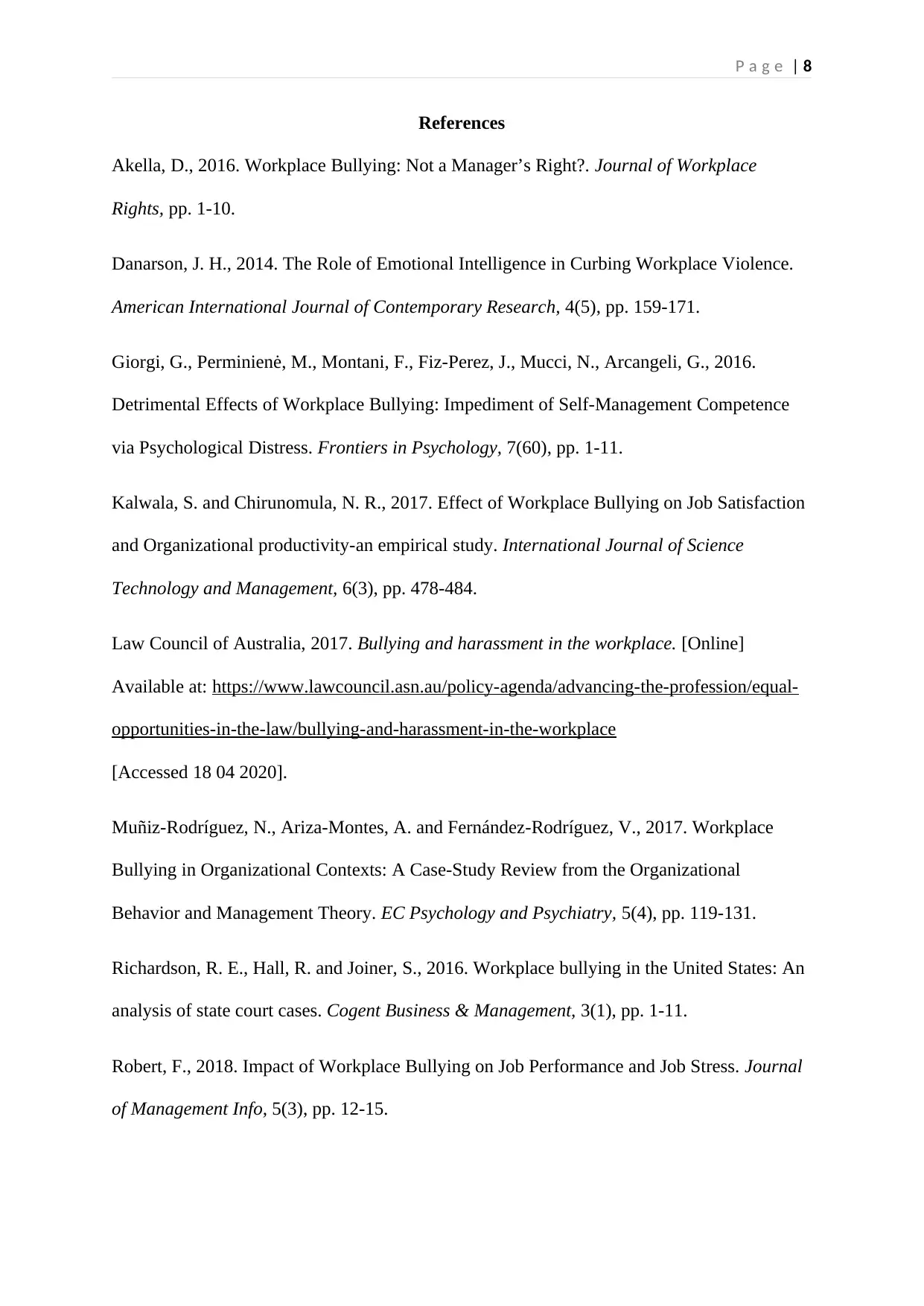
P a g e | 8
References
Akella, D., 2016. Workplace Bullying: Not a Manager’s Right?. Journal of Workplace
Rights, pp. 1-10.
Danarson, J. H., 2014. The Role of Emotional Intelligence in Curbing Workplace Violence.
American International Journal of Contemporary Research, 4(5), pp. 159-171.
Giorgi, G., Perminienė, M., Montani, F., Fiz-Perez, J., Mucci, N., Arcangeli, G., 2016.
Detrimental Effects of Workplace Bullying: Impediment of Self-Management Competence
via Psychological Distress. Frontiers in Psychology, 7(60), pp. 1-11.
Kalwala, S. and Chirunomula, N. R., 2017. Effect of Workplace Bullying on Job Satisfaction
and Organizational productivity-an empirical study. International Journal of Science
Technology and Management, 6(3), pp. 478-484.
Law Council of Australia, 2017. Bullying and harassment in the workplace. [Online]
Available at: https://www.lawcouncil.asn.au/policy-agenda/advancing-the-profession/equal-
opportunities-in-the-law/bullying-and-harassment-in-the-workplace
[Accessed 18 04 2020].
Muñiz-Rodríguez, N., Ariza-Montes, A. and Fernández-Rodríguez, V., 2017. Workplace
Bullying in Organizational Contexts: A Case-Study Review from the Organizational
Behavior and Management Theory. EC Psychology and Psychiatry, 5(4), pp. 119-131.
Richardson, R. E., Hall, R. and Joiner, S., 2016. Workplace bullying in the United States: An
analysis of state court cases. Cogent Business & Management, 3(1), pp. 1-11.
Robert, F., 2018. Impact of Workplace Bullying on Job Performance and Job Stress. Journal
of Management Info, 5(3), pp. 12-15.
References
Akella, D., 2016. Workplace Bullying: Not a Manager’s Right?. Journal of Workplace
Rights, pp. 1-10.
Danarson, J. H., 2014. The Role of Emotional Intelligence in Curbing Workplace Violence.
American International Journal of Contemporary Research, 4(5), pp. 159-171.
Giorgi, G., Perminienė, M., Montani, F., Fiz-Perez, J., Mucci, N., Arcangeli, G., 2016.
Detrimental Effects of Workplace Bullying: Impediment of Self-Management Competence
via Psychological Distress. Frontiers in Psychology, 7(60), pp. 1-11.
Kalwala, S. and Chirunomula, N. R., 2017. Effect of Workplace Bullying on Job Satisfaction
and Organizational productivity-an empirical study. International Journal of Science
Technology and Management, 6(3), pp. 478-484.
Law Council of Australia, 2017. Bullying and harassment in the workplace. [Online]
Available at: https://www.lawcouncil.asn.au/policy-agenda/advancing-the-profession/equal-
opportunities-in-the-law/bullying-and-harassment-in-the-workplace
[Accessed 18 04 2020].
Muñiz-Rodríguez, N., Ariza-Montes, A. and Fernández-Rodríguez, V., 2017. Workplace
Bullying in Organizational Contexts: A Case-Study Review from the Organizational
Behavior and Management Theory. EC Psychology and Psychiatry, 5(4), pp. 119-131.
Richardson, R. E., Hall, R. and Joiner, S., 2016. Workplace bullying in the United States: An
analysis of state court cases. Cogent Business & Management, 3(1), pp. 1-11.
Robert, F., 2018. Impact of Workplace Bullying on Job Performance and Job Stress. Journal
of Management Info, 5(3), pp. 12-15.
⊘ This is a preview!⊘
Do you want full access?
Subscribe today to unlock all pages.

Trusted by 1+ million students worldwide
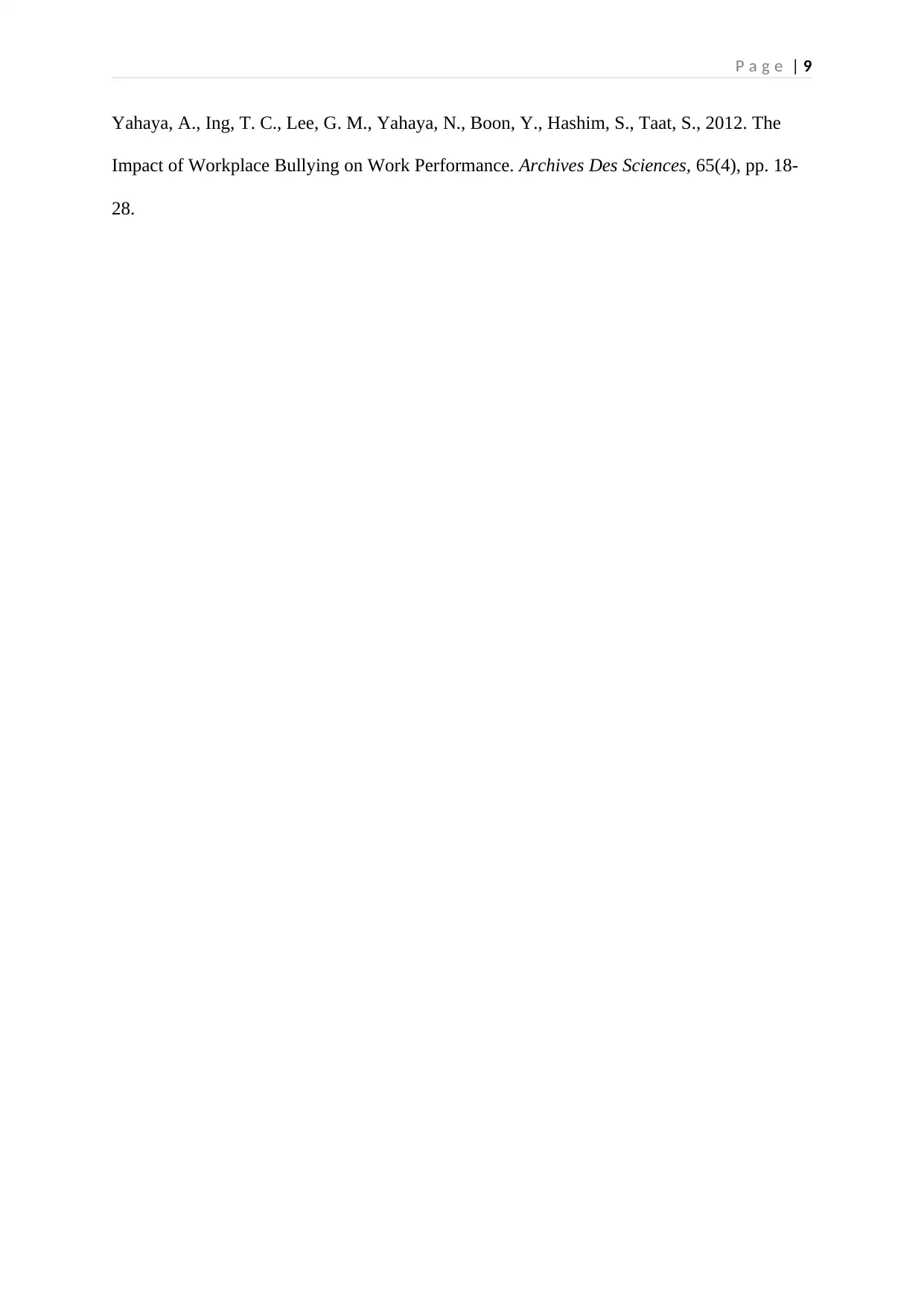
P a g e | 9
Yahaya, A., Ing, T. C., Lee, G. M., Yahaya, N., Boon, Y., Hashim, S., Taat, S., 2012. The
Impact of Workplace Bullying on Work Performance. Archives Des Sciences, 65(4), pp. 18-
28.
Yahaya, A., Ing, T. C., Lee, G. M., Yahaya, N., Boon, Y., Hashim, S., Taat, S., 2012. The
Impact of Workplace Bullying on Work Performance. Archives Des Sciences, 65(4), pp. 18-
28.
1 out of 10
Related Documents
Your All-in-One AI-Powered Toolkit for Academic Success.
+13062052269
info@desklib.com
Available 24*7 on WhatsApp / Email
![[object Object]](/_next/static/media/star-bottom.7253800d.svg)
Unlock your academic potential
Copyright © 2020–2025 A2Z Services. All Rights Reserved. Developed and managed by ZUCOL.




